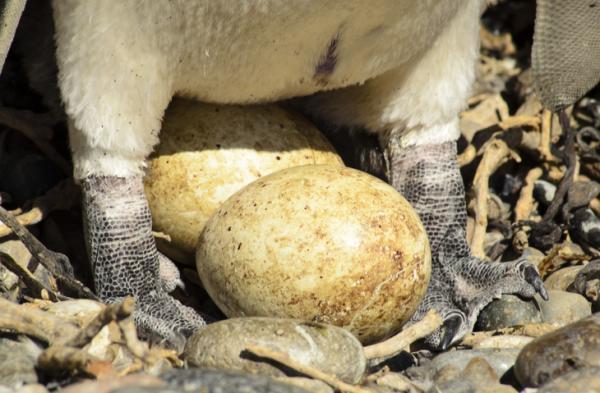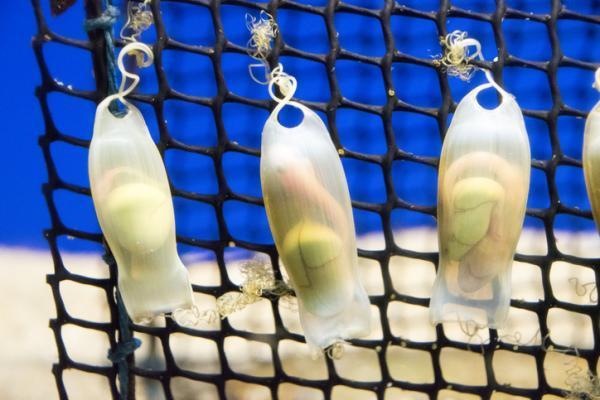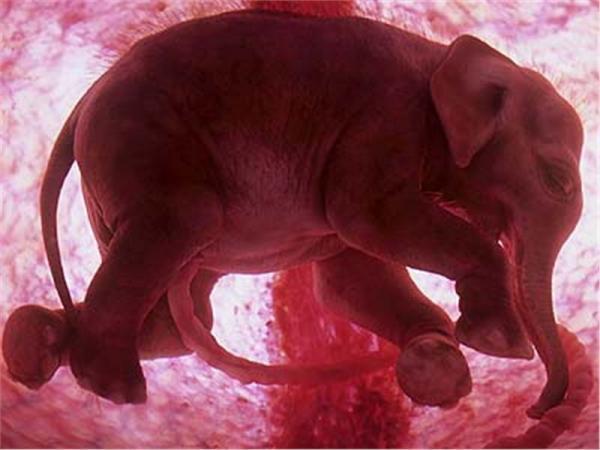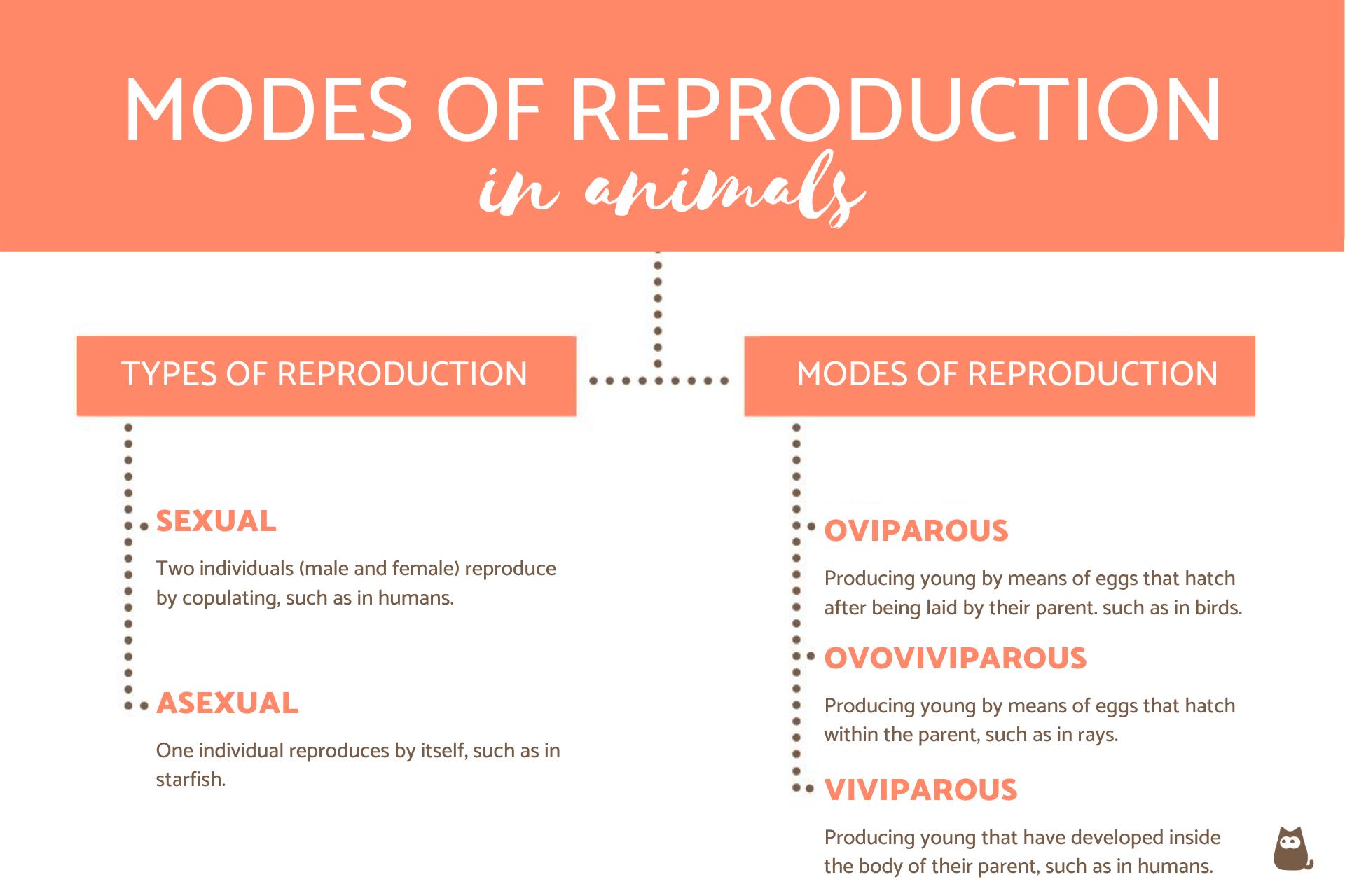Modes of Reproduction in Animals


The different modes of reproduction in animals is classified based on how they give birth to their young, this includes viviparous, oviparous and ovoviviparous animals. Embryos can be fertilized internally or externally, but the development after fertilization differ greatly.
In this AnimalWised article we're going to explain how animals reproduce and the different modes of reproduction in animals. We'll also include examples to give a better understanding. Keep reading to learn more!
Types of reproduction in animals
In the animal kingdom, there are different modes of reproduction. These can be either sexual or asexual reproduction:
- Asexual reproduction: in asexual reproduction, identical offspring originate from a single parent, which can occur in different ways. Hermaphroditic species fall into this group.
- Sexual reproduction: the other form of reproduction is sexual, which occurs through the copulation of the genetic material of two individuals. In the mode of sexual reproduction, fertilization can occur externally or internally. In the first case, we have as an example fish, amphibians and many invertebrates. The second case is typical of most reptiles, birds and mammals. For its part, the development of the zygote can also occur inside or outside the female, although the nutrition of the embryo can be dependent or independent of the mother.
In multicellular organisms such as animals and plants, sexual reproduction is much more common. It can even occur in some unicellular eukaryotic organisms such as amoebas. However, the mode of sexual reproduction does not strictly occur in prokaryotic unicellular organisms, even if some forms of asexual reproduction involve the sharing of genetic information.
Learn more in our article about types of animal reproduction. You can also watch the video below to learn more about modes of sexual and asexual reproduction in animals:

Modes of reproduction in animals
The mode of reproduction of each animal is established depending on where the development of the embryo occurs. Generally speaking, the main difference is whether the embryo develops internally or externally. The eggs can be fertilized internally or externally, but only internal fertilization will lead to internal development. There are no known animals which fertilize externally and then develop embryos internally as a mode of reproduction.
With this in mind, we can say there are three main modes of reproduction in animals. They are the following:
- Oviparous animals
- Ovoviviparous animals
- Viviparous animals
We look at each of these animal reproductive modes in more detail in the sections below. Learn more about how animals reproduce with our article on external fertilization in animals.
Oviparous animals
Fertilization in oviparous animals can occur internally or externally to the body. However, oviparity refers to the development of the embryo taking place outside the body of the female.
This is why the characteristics of the egg are essential for the embryo to develop outside of their parent. In this way, some oviparous produce dry eggs that are capable of resisting contact with the air, since they have a protective cover (shell). This is the case of birds and reptiles, although the characteristics of the shell can differ. The largest egg in this type of reproduction that we find today is that of the common ostrich (Struthio camelus).
Other groups of oviparous, produce smaller eggs that are not calcified such as most fish, some reptiles, amphibians and insects. In many cases this process occurs in an aquatic environment. Some oviparous animals leave their eggs once they are expelled, allowing their young to face the dangers of life alone. Others will take care of them until a certain age, by protecting them and even providing them with food once they are born.
Within the group known as oviparous animals, we also find two primitive mammals known as monotremes that reproduce this way. They are the platypus (Ornithorhynchus anatinus) and the echidna (family Tachyglossidae).
Examples of oviparous animals
Some examples of oviparous animals are:
- Birds: ostriches, chickens, ducks, geese, penguins, parrots, hummingbirds, storks.
- Fish: anchovies, piranhas, eels, salmon, tuna.
- Reptiles: snakes, lizards like the Komodo dragon, turtles, crocodiles.
- Insects: ants, bees, beetles, flies.
- Mollusks and crustaceans: snails, octopuses, crabs.
- Mammals: platypus and echidna.
Almost all frog species are oviparous animals, although there is at least one exception where live birth of tadpoles occurs (Limnonectes larvaepartus). Learn more with our guide to frog reproduction as we ask how do frogs reproduce?

Ovoviviparous animals
Ovoviviparity is the process of animals that are born from eggs, but fertilization is internal and embryonic growth also occurs within the parent.
The hatching of the egg in ovoviviparous animals can occur within the maternal organism, so that they give birth to live offspring directly from the parent's body. In some cases, the egg can be expelled outside when it is already developed. They will either open immediately or shortly after being laid.
As in the case of oviparous animals, the nutrition of the offspring depends on what is contained within the egg. In many ways, it is considered a bridge between oviparity and viviparity since it involves different aspects of each process. This group is made up of several types of invertebrates, some fish, such as the great white shark (Carcharodon carcharias), and certain reptiles, such as the Jackson's chameleon (Trioceros jacksonii) species.
Examples of ovoviviparous animals
Some examples of ovoviviparous animals are:
- Reptiles: rattlesnake, some lizards.
- Amphibians: some species of salamanders.
- Fish: white shark, manta ray.
- Insects: certain species of flies.

Viviparous animals
Viviparous animals are those whose fertilization is internal and the embryo develops within the body of their parent. In this case, it is the parent that provides them with the nutrition and protection throughout the process. They usually do so via a placenta.
Here we find almost all mammals, including bats. The different types of marsupials are also viviparous. However, their reproductive system differs from the rest since the embryo is born without being fully developed and the process culminates in the marsupial bag. This is the case of the koala (Phascolarctos cinereus). As in the previous classifications of animals according to their reproduction, there are exceptions. An example is the fat-tailed scorpion (Androctonus crassicauda).
The modes of reproduction in viviparous animals are the most diverse when we compare them with oviparous or ovoviviparous animals. This is largely due to the strategies they use for nutrient provision from the parent to the offspring. We look at some of these reproductive strategies below:
Placental viviparity
Placental viviparity is the mode of reproduction seen in most mammals, including humans. A placenta forms and attaches to the lining of the uterus, creating a structure through which nutrients, gases and waste are exchanged between the mother and the embryo. The placenta allows for a high degree of nutrient and oxygen transfer, enabling the embryo to grow more rapidly and reach a more advanced stage of development by birth.
Aplacental (or non-placental) viviparity
Aplacental viviparity occurs when embryos develop inside the parent's body, but do not transfer nutrients and oxygen via a true placenta. Instead, the embryos are nourished by other means, which can be categorized into various forms. They are:
- Yolk-sac viviparity: in this form, embryos rely on a yolk sac for nutrients, similar to what occurs in oviparous (egg-laying) animals, but they still develop inside the mother. Once the yolk sac is depleted, the embryo may rely on additional nutrient sources if available.
- Histotrophic viviparity: in this mode, embryos consume nutrient-rich secretions produced by the mother's reproductive tract after yolk resources are exhausted. These secretions sustain the embryos until they are ready to be born.
- Oophagy: embryos consume unfertilized eggs produced by the mother, providing an additional nutrient source beyond the initial yolk sac.
- Adelphophagy (intrauterine cannibalism): adelphophagy is a rare form of viviparity which occurs when the largest embryo consumes its smaller siblings within the uterus, thereby gaining additional nutrition.
Examples of viviparous animals
We look at some of the examples of oviparous animals within the animal kingdom:
- Mammals: all except the platypus and echidna.
- Fish: some sharks, such as hammerhead.
- Reptiles: some snakes, such as boas and certain lizards.
- Amphibians: some species of salamanders.

Other modes of reproduction in animals
The classification of animals according to their reproduction is a complex process. As we have seen in this article, there are always exceptions within the animal kingdom. Absolute categorizations cannot be established to define each group as oviparous, ovoviviparous or viviparous.
For example, did you know that it is actually the father seahorse that carries the young after fertilization? Once the egg is fertilized, the mother's job is done and she swims away. In this case, it's the father who carries and cares for their young until they are old enough to survive on their own. To learn more, read our article about the 10 best animal dads.
If you want to read similar articles to Modes of Reproduction in Animals, we recommend you visit our Facts about the animal kingdom category.
- Curtis, H., Barnes, N., Schnek, A., & Massarini, A. (2008). Biology. Panamerican Medical Publishing House: Madrid.
- Hickman, C., Roberts, L., & Parson A. (2000). Comprehensive principles of zoology. McGraw Hill Interamericana: Spain.
- Galán, P. (2009). Ecology of the reproduction of Iberian saurians. http://www.herpetologica.org/BAHE/BAHE20_003_Invitado.pdf








